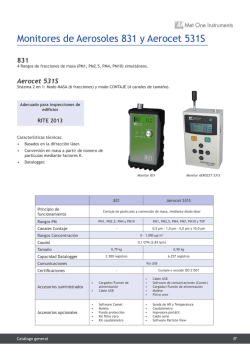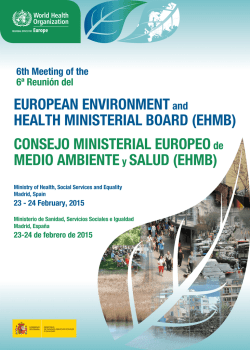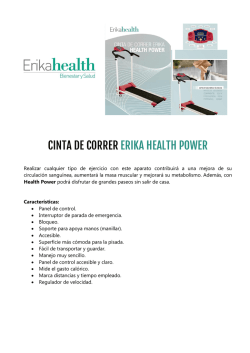
La salud ambiental y los Objetivos de Desarrollo
SIMPOSIO REGIONAL OPS/OMS "Agua y Saneamiento en la Agenda 2030: La Ruta para el Desarrollo Sostenible” Cartagena, Colombia. Local: Hotel de Las Américas 18 al 20 de agosto de 2016. Previo al XXXV Congreso de AIDIS. La salud ambiental y los Objetivos de Desarrollo Sostenible Carga de enfermedades de los riesgos ambientales en las Americas 0,25 0,20 0,15 % deaths attributable to the environment 0,10 0,05 % DALYs attributable to the environment KNA BHS URY TTO CAN USA BRB CHL ATG ARG DMA BLZ MEX GRD JAM PAN CUB CRI LCA VCT BRA ECU PER SUR COL SLV GTM VEN BOL GUY DOM PRY NIC HND HTI 0,00 Las diferencias entre los países ~ 3 veces para la mortalidad y ~ 2 veces por AVAD: 8 al 23% de las muertes atribuibles a los riesgos ambientales 10 a 23% de los AVAD atribuibles a los riesgos ambientales Para las enfermedades no transmisibles: la mortalidad estandarizada por edad varía de 35 (Canadá) a 163 y 176 / 100.000 per cápita de Guyana y Haití, respectivamente; Los anos de vida vividos con discapacidades (DALYs) por edad estandarizada / 100.000 per Proyecto en desarrollo : Medir el progreso de los Objetivos de Desarrollo Sostenible (ODM) en las Américas: Indicadores de Salud Ambiental Objetivo • Teniendo por base la lista de indicadores propuestos por la ONU y la experiencia en la salud ambiental de los países de la Región de las Américas, evaluar las fortalezas y deficiencias de la capacidad regional, y discutir metodologías para medir el progreso hacia el logro de los ODS relacionados con salud ambiental en la región. Estos indicadores deben estar vinculados a los temas prioritarios de salud pública regional y de acuerdo con los mandatos de la OMS / OPS. Indicadores de Salud y Ambiente de la OPS • • • • • • Agua Saneamiento Uso de combustibles solidos Contaminacion del aire Seguridad quimica Cambio climatico • Otros: RSI, Disastres, Lesiones • *El 2016, % uso de biomassa incluido en los indicadores basicos de la OPS Decision tree to be used in the exercise with each UN SDG Indicator considered priority for environmental health SDE/Pan American Health Organization Workshop Assessing the Status of the Environmental Health Indicators for the SDGs in the Americas - April 2016 Q1. Are there indicators already measured by PAHO or other agencies that relates to this topic? no yes ACTIONS Develop the indicators, methods, and capacity-building strategy in the countries of the region Q2. Is PAHO’s indicator (or the other agency) adequate to measure SDG progress? no yes ACTIONS Develop the indicators, methods, and capacitybuilding strategy in the countries of the region Q3. The methods used are adequate to measure the indicator at country level and regional level? no yes ACTIONS Propose adaptations to the method of measurement to attend countries’ specificities, making sure they are compatible for reporting at regional level no ACTIONS Propose resource mobilization and/or capacity-building strategies to help increase the number of countries measuring and reporting the indicator Q4. Do all countries / agencies use similar or compatible methods to measure the indicator? yes Other considerations/needs identified? Quieres colaborar? Sitio colaborativo (necesita invitation) – favor contactar a [email protected] HTTPS://COLLABORATION.PAHO.ORG/EHI/SITEPAGES/HOME.ASPX Como reducer la carga de enfermedades atribuibles a los ambientes insalubres en las Americas? Abordar las vulnerabilidades en la salud publica Agnes Soares, SDE PAHO/WHO 12 La contaminacion del aire es un problema prioritario de salud publica • • • • • 152.000 muertes atribuibles a la contaminación del aire ambiente en las Américas en 2012 (OMS, 2014) 80.000 muertes atribuibles a la contaminación del aire del hogar en ALC para el año 2012 (OMS, 2014) representa la contaminación del aire por alrededor de 1 de cada 8 muertes en general Contribuye de manera significativa a las enfermedades no transmisibles: cáncer, enfermedades cardiovasculares, enfermedades pulmonares obstructivas crónicas y asma Contribuye de manera significativa a las infecciones respiratorias bajas WHO Air Quality Guidelines PM10 (µg/m3) PM2.5 (µg/m3) Nivel 1 70 35 Riesgo de mortalitad 15% > AQG Nivel 2 50 25 Riesgo de mortalidad ~ 6% < Tier 1 Nivel 3 30 15 Riesgo de mortalidad ~ 6% < Tier 2 AQG 10 Nivel minimo donde se han observados efectos para la salud 20 WHO Air Quality Guidelines, update 2005 http://www.who.int/phe/health_topics/outdoorair/outdoorair_aqg/en/ WHO guidelines for indoor air quality: household fuel combustion http://www.who.int/indoorair/publications/household-fuel-combustion/en/ 14 Enfermedades asociadas con la contaminación del aire Balakrishnan K et al. Environmental Health, 2013,12:77; Burnett R et al., Environmental Health Perspectives, 2014,Vol. 22:4; Smith K, Bruce N et al. Annu. Rev. Public Health, 2014, Vol. 35; IER function*: PM2.5 and child ALRI risk Household air pollution (red) Second-hand smoking (blue) Outdoor air pollution (green) *Burnett et al EHP 2014 IER function for PM2.5 and child ALRI risk (linear scale) WHO IT-1 (35 µg/m3 PM2.5) Require exposure reduction to around IT-1 or less to prevent majority of attributable cases Stroke Lung Cancer COPD Ischemic Heart Disease ug/m3 annual average PM2.5 Air pollution management and control in Latin America and the Caribbean City population size ≥100,000 <500,000 ≥500,000 <1000,000 ≥1000,000 <5000,000 ≥5000,000 <10,000,000 ≥10,000,000 Number of cities PM10 455 57 35 5 3 555 11 11 14 5 3 44 PM2.5 34 5 8 5 2 54 Number of cities monitoring PM10 and PM2.5 per population size in LAC • PM10 is regulated in 19/33 countries; • PM2.5 is regulated in 13/33 countries WHO AQG IT-1 IT-2 IT-3 > IT-3 TOTAL PM10 PM2.5 1 4 9 18 8 8 44 12 23 9 6 54 Mean annual levels of PM10 and PM2.5 in LAC cities with ground level monitoring stations compared to WHO AQG Riojas-Rodríguez, H; Soares da Silva A; Texcalac-Sangrador JL; Moreno-Banda GL. Air pollution management and control in Latin America and the Caribbean and implications for climate change. Rev Panam Salud Publica. 2016 (forthcoming) Monitoring stations in 77 cities distributed in 17 /33 LAC countries PM10 – 44 cities PM2.5 – 54 cities Coverage ~133 million people. Riojas-Rodríguez, H; Soares da Silva A; Texcalac-Sangrador JL; Moreno-Banda GL. Air pollution management and control in Latin America and the Caribbean and implications for climate change. Rev Panam Salud Publica. 2016 (forthcoming) Sulphur content in diesel Mexico City has registered only 20 “clean” days in 2016 according to national air quality standards. - Legislation updated in 2015 in a participatory process - Difficulties on implementing and sustaining interventions to reduce emissions 22 Household air pollution in LAC Typical wood cookfire releases the equivalent of ~400 cigarettes per hour worth of smoke LAC countries with 10% or more of SFU 120 100 80 1990 2000 60 2010 40 2013 20 0 HAI HTI GUT GTM NIC NIC HON PER HND PAR PRY PER BOL BOL ELS SLV MEX PAN COL MEX PAN COL Fuente: WHO Global Health Observatory Data Repository. Population Using Solid Fuels. World Health Organization. http://apps.who.int/ghodata/# 24 We must not remain gradient-blind ESTADO # Hogares usuarios de leña (2010) INEGI IDH % Población Indígena (INEGI) CHIAPAS 698,406 (58%) 0.66 15 - 19 OAXACA GUERRERO MICHOACAN VERACRUZ GUANAGUATO HIDALGO 582,984 (61%) 433,432 (51%) 294,595 (27%) 858,395 (44%) 161,278 (12%) 224,457 (34%) 0.67 0.67 0.70 0.71 0.71 0.72 > 19 4-8 4 4-8 <4 15 - 19 PUEBLA ZACATECAS SAN LUIS POTOSÍ CHIHUAHUA DURANGO NAYARIT YUCATÁN MÉXICO TABASCO QUINTANA ROO 477,728 (33%) 49,351 (13%) 198,639 (30.7%) 84,659 (10%) 67,893 (17%) 49,873 (18%) 240,679 (49%) 340,852 (9%) 255,730 (46%) 58,354 (18%) 0.72 0.72 0.73 0.73 0.73 0.73 0.74 0.74 0.74 0.75 4-8 <4 4-8 <4 <4 <4 > 19 4 <4 15 - 19 CAMPECHE JALISCO MORELOS QUERETARO SINALOA TAMAULIPAS NUEVO LEÓN 61,328 (30%) 108,766 (6%) 59,787 (13%) 62,106 (13%) 98,811 (15%) 57,208 (7%) 30,226 (3%) 0.75 0.75 0.75 0.76 0.76 0.76 0.79 8-15 <4 <4 <4 <4 <4 <4 - Know, document, and target differently - Measure the effect of the interventions One solution does not fit all Rural x Urban Figura 1: Concentration index of the exposure to biomass as determined by the social gradient defined by human development in 21 Latin American and Caribbean countries Figura 2: Solid fuel use in urban and rural areas as a function of HDI in 21 Latin America and Caribbean countries 58,2% of the population exposed to solid fuels in LAC is concentrated in countries in the lowest HDI quartile while only 5% live in countries in the highest HDI quartile. Rural/urban differences are only 2.3 in the lowest quartile and 11.7 in the highest quartile. For solid fuel users, expect varying rates of adoption of clean fuels across society ... (urban x rural x socioeconomic status) 27 Also, transition of household energy mix over time Policy should aim to accelerate shift to more exclusive use of cleanest fuels and technologies for all energy needs in the home 90 % HH energy use from fuel (by cost) 80 70 60 Biomass 50 Gas 40 Kerosene Electricity 30 20 10 0 Year 2015 Year 2020 Year 2025 Year 2030 Para acceder a la pagina del seminario sobre contaminación del aire de la AIDIS http://aidisnet.org/html/esp/not_13etan.html Para acceder a la base de datos de la OMS (en inglés) donde hay información sobre la contaminación del aire en las ciudades: http://www.who.int/phe/health_topics/outdoorair/databases/cities/en/ Para el informe sobre la carga de enfermedades atribuibles a la contaminación del aire: http://www.who.int/phe/health_topics/outdoorair/databases/en/# Para el informe sobre la carga de enfermedades atribuibles al ambiente (EN): http://www.who.int/quantifying_ehimpacts/publications/preventing-disease/en/ Sobre la contaminación del aire intramuros, siga nuestra página: http://www.paho.org/hq/index.php?option=com_content&view=article&id=11049%3A2015household-air-pollution&catid=8026%3Ahousehold-air-pollution&Itemid=41516&lang=es Thank you! Gracias! Obrigada! [email protected] Curitiba, Brazil, 2012, by ®Eugenia Rodrigues 30
© Copyright 2025




